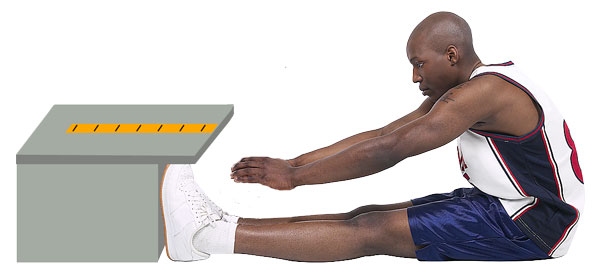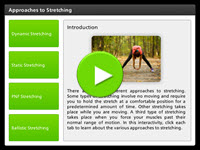Stretching
Sit-and-Reach
You now know that stretching is the way to improve your flexibility. To test your level of flexibility in your back and hamstrings, you can take a sit-and-reach test. The procedure for the sit-and-reach test is as follows:
- A sit-and-reach box is used for this test, which has a ruler on it. If you do not have access to a sit-and-reach box, you may make one out of a box and a ruler.
- You sit facing the box, legs straight, with your feet flat against the box. Make sure you do not have on shoes (although the image below shows shoes worn).
- Place your hands together, one on top of the other, with finger-tips even. Reach three times in front of you by bending at the waist. On the third time, hold the stretch. Your instructor records the score or how far you can reach.

The average range of stretch for teenage males is eight inches. The average range of stretch for teenage females ages 13–14 is ten inches, and for teenage females ages 15 and older it is twelve inches.
Approaches to Stretching
 Before you exercise, workout, or participate in a sport, how do you stretch? Did you know that there are several different approaches to stretching? Stretching can occur in motion, not in motion, or when you force your muscles past their range of motion. In this interactivity, explore the three different approaches to stretching. Click the player button to begin,
Before you exercise, workout, or participate in a sport, how do you stretch? Did you know that there are several different approaches to stretching? Stretching can occur in motion, not in motion, or when you force your muscles past their range of motion. In this interactivity, explore the three different approaches to stretching. Click the player button to begin,
View a printable version of this interactivity.
If your activity level remains low throughout your teen years, you are more likely to have poor flexibility. This in turn, can cause poor posture, lower back pain, and a decrease in circulation. That is why it is important to be active during your teen years. The healthy habits you develop now can help you tremendously as you get older. Just as it is important for your overall health to have a strong cardiovascular system and good muscular strength and endurance, it is important to maintain good flexibility.
Stretching Examples
 Before you begin stretching, you need to warm up your muscles. Stretching cold muscles can be dangerous because you may strain or pull a muscle. To warm up, you can go on a brisk walk, march in place, or do jumping jacks, jog, jog in place, or take a leisurely bike ride and then begin your stretching routine. Your warm up should last between five to ten minutes. You should follow your exercise session with a cool down, which includes five to ten minutes of light activity and stretching. In this interactivity, learn how to perform various stretches. Click the player button to get started.
Before you begin stretching, you need to warm up your muscles. Stretching cold muscles can be dangerous because you may strain or pull a muscle. To warm up, you can go on a brisk walk, march in place, or do jumping jacks, jog, jog in place, or take a leisurely bike ride and then begin your stretching routine. Your warm up should last between five to ten minutes. You should follow your exercise session with a cool down, which includes five to ten minutes of light activity and stretching. In this interactivity, learn how to perform various stretches. Click the player button to get started.
View a printable version of this interactivity.
Please note that some stretches can be done in different ways that were not included in the interactivity. If any of the stretches cause pain or discomfort, immediately stop the stretch and consult your instructor for an alternative stretching technique. Also, due to the risks associated with ballistic stretching, only experienced athletes should perform ballistic stretches.
Stretching Review
![]()
 Now that you have explored flexibility, review your knowledge in this non-graded activity. Click the player button to get started.
Now that you have explored flexibility, review your knowledge in this non-graded activity. Click the player button to get started.